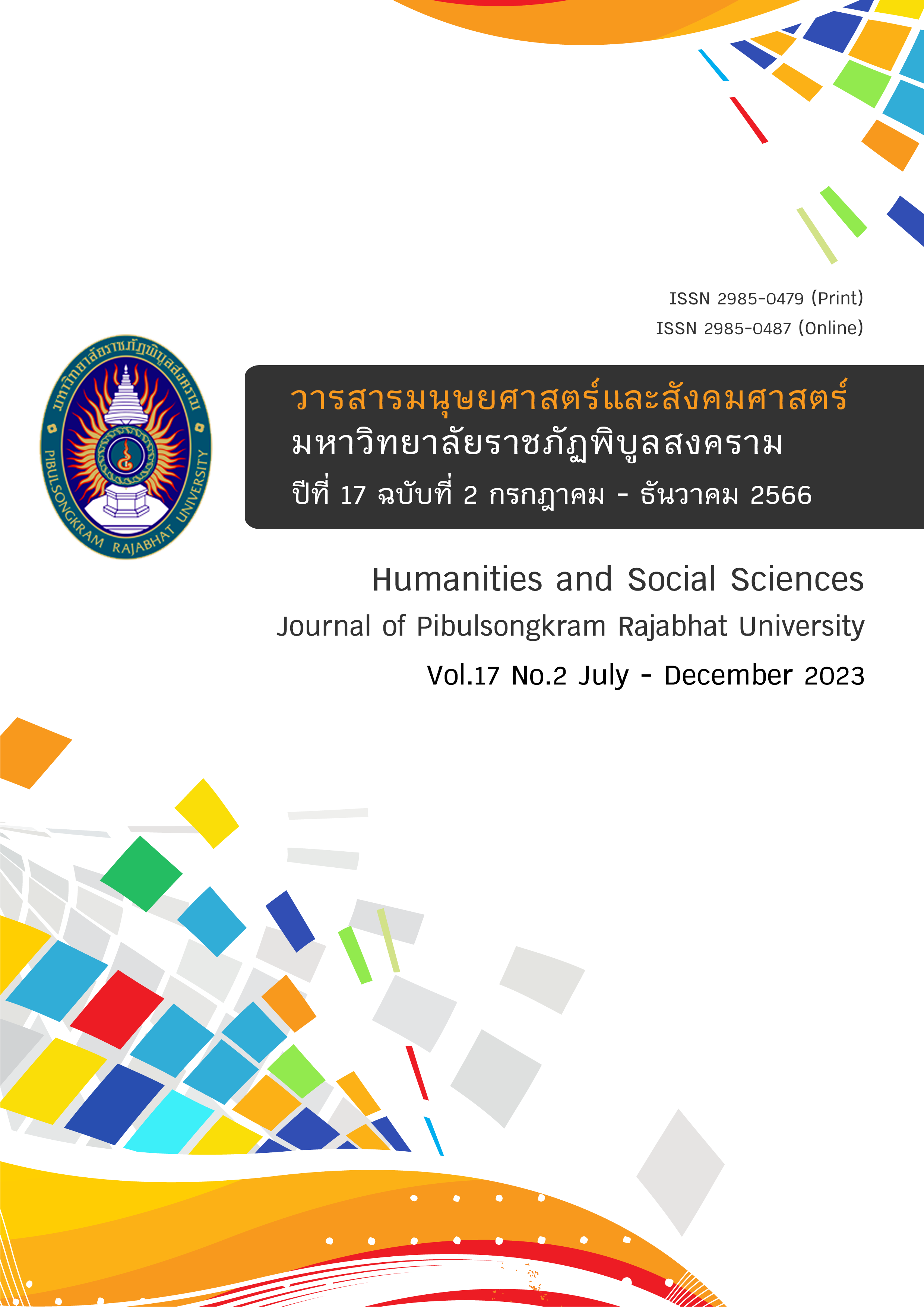Psychological Safety and Safety Culture as Predict of Retail Business Employees Occupational Safety Behavior
DOI:
https://doi.org/10.14456/psruhss.2023.55Keywords:
Psychological safety, Safety culture, Occupational safety behavior, Retail businessAbstract
The objectives of this research were to: 1) levels of occupational safety behavior, psychological safety and safety culture of employees in the retail business; 2) the relationship between psychological safety and occupational safety behavior of employees in the retail business; 3) the relationship between safety culture and occupational safety behavior of employees in the retail business; 4) and, to predict occupational safety behavior with psychological safety and safety culture of employees in retail business. The participants were 454 employees from 3 retail businesses. The instrument employed in the research was a rating scale questionnaire. The statistics used to analyze data were percentage, mean, standard deviation, Pearson Product Moment Correlation Coefficient and stepwise multiple regression analysis. The results revealed that 1) the occupational safety behavior of employees in the retail business group was at the highest level, psychological safety was at a high level, and safety culture was at a high level; 2) there was a positive relationship between psychological safety and occupational safety behavior with a statistical significance level at .01; 3) there was a positive relationship between safety culture and occupational safety behavior with a statistical significance level at .01; and 4) psychological safety in both inner safety and physical risk, and safety culture in both reporting culture and learning culture together can predict occupational safety behavior at 71 percent (R2 = 0.71) with a statistical significance level at .01. To increase occupational safety behavior to a higher level. An organization organizes activities that promote bonding between colleagues and organizations, awarding rewards to employees who do good deeds. Promote safety news to employees and brainstorm ideas from employees to build a learning society.
References
บัณฑิตา อินสมบัติ. (2554). ข้อพิจารณาในการคัดเลือกข้อคำถามที่มีอำนาจการจำแนก. วารสารวิชาการบัณฑิตศึกษา มหาวิทยาราชภัฏนครสวรรค์, 6(16), 1-12.
วิทิต กมลรัตน์. (2552). ศึกษาพฤติกรรมความปลอดภัยในการปฏิบัติงานของพนักงานฝ่ายปฏิบัติการ บริษัท อดิตยา เบอร์ล่า เคมีคัลส์ (ประเทศไทย) จำกัด (ฟอสเฟต ดีวิชั่น) (สารนิพนธ์วิทยาศาสตรมหาบัณฑิต). กรุงเทพฯ: สถาบันบัณฑิตพัฒนบริหารศาสตร์.
Abror, A. (2017). The relationship between psychological safety, self-efficacy and organisational performance: a case in Indonesian companies (Doctoral dissertation). University of Hull.
Arghami, S., & Taghizade, F. (2017). Investigating the Relationship between Employee Safe Behavior and Safety Culture in a Livestock Industry. Journal of Human, Environment, and Health Promotion, 2(3), 193-198.
Bowman, C., Neeman, N., & Sehgal, N. L. (2014). Enculturation of unsafe attitudes and behaviors: student perceptions of safety culture. Acad Med., 88(6), 802–810. doi: 10.1097/ACM.0b013e31828fd4f4.
Carmeli, A., Brueller, D., & Dutton, J. E. (2009). Learning behaviours in the workplace: The role of high‐quality interpersonal relationships and psychological safety. Systems Research and Behavioral Science: The Official Journal of the International Federation for Systems Research, 26(1), 81-98.
Cooper, D. (2002). A model for understanding and quantifying a difficult concept. Professional Safety.
Cronbach, L. J. (1990). Essentials of psychological testing (5th ed.). New York: Harper & Row.
Duhigg, C. (2016). What Google learned from its quest to build the perfect team. The New York Times Magazine.
Dursun, S., & Aytac, S. (2011). The Effect of Safety Culture on Safety in an Organizational Structure: A Case Study in Turkey. Human Factors In Organizational Design And Management – X, 6(1), 173-179.
Edmondson, A. (1999). Psychological Safety and Learning Behavior in Work Teams. Administrative Science Quarterly, 44(2), 350-383.
Firenze, R. J. (1978). The Process of Hazard Control. New York: Kendall/Hunt.
Geller, E. S. (1994). Ten principles for achieving a Total Safety Culture. Professional Safety, 39(9), 18-24.
Hatanaka, I. (2000). A Model-based Framework for Risk Assessment in Human-Computer Controlled Systems. the Degree of Master of Science in Engineering and Management, United States: Massachusetts Institute of Technology.
Hudson, P. (2001). Safety Management and Safety Culture: The Long, Hard and Winding Road. Occupational Health and Safety Management Systems.
Hudson, P. T. W. (2001). Safety management and safety culture: the long, hard and winding road. Occupational health and safety management systems, 3-32.
Kark, R., & Carmeli, A. (2009). Alive and creating: The mediating role of vitality and aliveness in the relationship between psychological safety and creative work involvement. Journal of Organizational Behavior: The International Journal of Industrial, Occupational and Organizational Psychology and Behavior, 30(6), 785-804.
Krejcie, R. V., & Morgan, D. W. (1970). Determining sample size for research activities. Educational and psychological measurement, 30(3), 607-610.
Larsson, S., Pousette, A., & Törner, M. (2008). Psychological climate and safety in the construction industry-mediated influence on safety behaviour. Safety Science, 46(3), 405-412.
Lee, T. R. (1996). Perceptions, attitudes and behaviour: the vital elements of a safety culture. Health and Safety, 10, 1-15.
Mokarami, H., Alizadeh, S. S., Pordanjani, T. R., & Varmazyar, S. (2019). The relationship between organizational safety culture and unsafe behaviors, and accidents among public transport bus drivers using structural equation modeling. Transportation research part F: traffic psychology and behaviour, 65, 46-55.
Morrow, S. L., McGonagle, A. K., Dove-Steinkamp, M. L., Walker Jr, C. T., Marmet, M., & Barnes-Farrell, J. L. (2010). Relationships between psychological safety climate facets and safety behavior in the rail industry: A dominance analysis. Accident Analysis & Prevention, 42(5), 1460-1467.
Reason, J. (1997). Managing the risks of organizational accidents. United Kingdom: Taylor & Francis.
Rovinelli, R. J., & Hambleton, R. K. (1977). On the use of content specialists in the assessment of criterion-referenced test item validity. Dutch Journal of Educational Research, 2, 49-60.
Downloads
Published
How to Cite
Issue
Section
License
Copyright (c) 2021 Humanities and Social Sciences Journal of Pibulsongkram Rajabhat University

This work is licensed under a Creative Commons Attribution-NonCommercial-NoDerivatives 4.0 International License.
Any articles or comments appearing in the Journal of Humanities and Social Sciences, Rajabhat Phibulsongkram University, are the intellectual property of the authors, and do not necessarily reflect the views of the editorial board. Published articles are copyrighted by the Journal of Humanities and Social Sciences, Rajabhat Phibulsongkram University.









